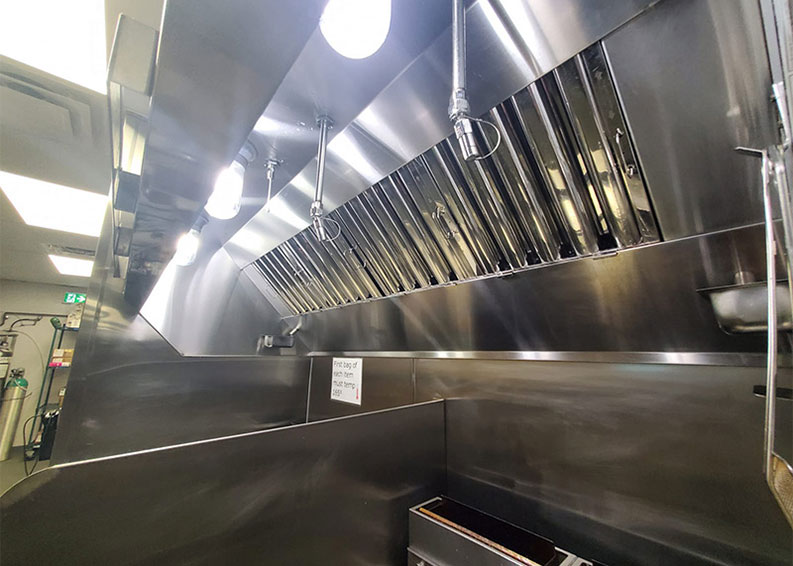
Kitchen exhaust cleaning is required by law for virtually every commercial cooking establishment in the United States. Restaurants, hospitals, hotels, employee cafeterias and other food-service locations have a “hood” and ductwork over the stove to exhaust smoke, steam, and fumes out of the building. These exhaust gases leave a residue on the inside of the ductwork. This is usually a grease residue of some sort, depending on the type of cooking. Charbroilers commonly leave heavy black grease. Chinese cooking normally deposits a sticky or rubbery residue. When charcoal or wood-burning stove is in use soot and ash residue builds up in the ductwork. Dishwashers leave heavy lint deposits. When the buildup of grease becomes heavy, a fire hazard exists. Approximately one of three restaurant fires is caused by grease. A common scenario of how a kitchen exhaust fire starts is this:
A flame flares up on the stove.
The fire contacts the filters above the stove on the kitchen hood. The filters ignite.
Since the exhaust fan is on, drawing air into the hood, through the filters, and up the duct, the flame on the filters is pulled into the duct. If significant grease residue exists on the duct interior, this can act as a fuel and the fire spreads up the duct, perhaps all the way into the fan. We have seen fire climb up a ten-story duct to the fan on the roof and burn up the fan.
Modern duct construction is designed to hopefully withstand such duct fires. The duct seams are welded to prevent grease or fire from leaking out and the shafts around the duct are made of fire-resistive materials. However, older buildings are still at risk, and even in modern ones the fire may leak out or could come out onto the roof via the fan. When an exhaust system is cleaned regularly, however, the chances of a duct fire are extremely remote
How often to clean
How often should a kitchen exhaust be cleaned? The most common cleaning frequency is every 3 months. This can vary, however. The kitchen exhaust systems that need cleaning most often are those over wood-burning or charcoal-burning stoves. These should be cleaned every month at least, and in some cases as often as every 2 weeks.
Below are various types of cooking establishments and their most commonly recommended cleaning frequencies.
Wood-burning or charcoal-burning stoves, charbroilers, 24-hour restaurants, and some hamburger places: 30 DAYS
Many hamburger restaurants and fast-food locations: 60 DAYS.
Average restaurant, employee cafeteria, and hotel or hospital kitchen: 90 DAYS.
Pizza places, convalescent hospital, small snack bar, oven hood: 180 DAYS.
Hoods over non-grease-creating appliances, such as steam kettles, dishwashers, soup vats, etc. ONE YEAR.
Kitchen exhaust cleaning is a standard part of the routine maintenance of any cooking establishment. All kitchen managers and restaurant owners should be aware of its role in fire prevention and ensure it is done on a regular basis.



Comments are closed